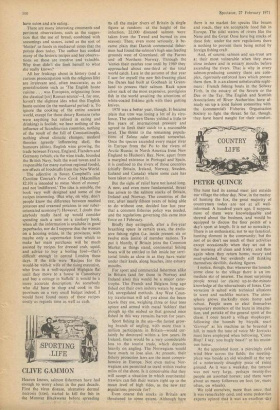CLIVE GAMMON
Heaven knows, salmon fishermen have had enough to worry about in the past decade. First the virus disease, ulcerative dermal necrosis (IJDN), started to kill the fish in the Munster Blackwater before spreading to all the major rivers of Britain (a single figure at random: at the height of the infection, 22,000 diseased salmon were taken from the Tweed and burned in one season). Then, even more seriously, it be- came plain that Danish commercial fisher- men had found the salmon's high seas feeding grounds west of Greenland, off the Faroes and off Northern Norway. Through the 'sixties their catches rose until by 1969 they approached about one-third of the total world catch. Late in the autumn of that year I saw for myself the new fish-freezing plant the Danes had built at Godhaab in Green- land to process their salmon. Rack upon silver rack of the most expensive, prestigious fish in the world awaiting the attentions of white-coated Eskimo girls with their gutting knives.
1970 was a better year, though. It became plain that UDN was losing a lot of its viru- lence. The stubborn Danes yielded a little to
five years of international pressure and agreed to limit their catch to a reasonable level. The threat to the remaining popula- tions of Salmo salar receded somewhat.
Once the species ascended every major river in Europe from the Po to the rivers of Arctic Russia; in North America from New England to Hudson's Bay. Now, apart from a marginal existence in Portugal and Spain, it is confined to the rivers of those countries (chiefly Britain, Ireland, Norway, Sweden, Iceland and Canada) where some care has been taken to protect it.
But the sighs of relief have not lasted long. A new, and even more fundamental, threat has arisen to the salmon stocks of Britain,
'Ireland and Norway. The countries of the EEC, after nearly fifteen years of being able
to do without one, decided late last year that a common fisheries policy was needed, and the regulations governing this came into force on 1 February.
Briefly they extinguish, after a five-year breathing space in certain cases, the exclu- sive fishing rights (i.e. inside present six or twelve mile limits) of member nations. To put it bluntly, if Britain joins the Common Market as things stand, continental fishing boats will be entitled to fish inside her terri- torial limits as close in as they have water under their keels, along beaches, into estuary mouths.
For sport and commercial fishermen alike in Britain (and for those in Norway and Ireland also) this would be a major catas- trophe. The French and Belgians long ago fished out their own inshore waters by waste- ful, unregulated Methods. Any West Coun- try trawlerman will tell you about the beam trawls they use, weighing three or four tons apiece and armed with metal 'ticklers' that plough up -the seabed so that ground once fished in this way remains barren for years.
Sport fishing in the sea—the fastest grow- ing branch of angling, with more than a million participants in Britain—would cer- tainly be destroyed within a few years. In
Ireland, there would be a very considerable loss to the tourist trade, which depends heavily on angling. The Norwegians would have much to lose also. At present, their ' fishery protection laws are the most compre- hensive in Europe. Not even native Nor- wegians are permitted to trawl within twelve miles of the shore. Is it conceivable that they will accept a situation in which continental trawlers can fish their waters right up to the mean level of high tides, as the new EEC regulations provide for?
Even coarse fish stocks in Britain are threatened to some extent. Although here there is no market for species like bream and roach, they are acceptable food fish in Europe. The tidal waters of rivers like the Nene and the Great Ouse have big stocks of these fish: under the new regulations there is nothing to prevent them being netted by foreign fishing craft.
And, of course, salmon and sea-trout are at their most vulnerable when they mass close inshore and in estuary mouths before ascending the rivers. That is why in every salmon-producing country there are com- plex, rigorously-enforced laws which protect them then. It is an almost unbelievable night- mare: French fishing boats in the Solway Firth, in the estuary of the Severn or the Dee or the Tay. The English and Scottish Associations of River Authorities have al- ready set up a joint liaison committee with the (commercial) Fisheries Organisation Society to fight the threat. So far, though, they have heard naught for their comfort.


































 Previous page
Previous page